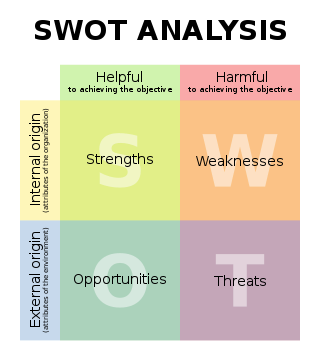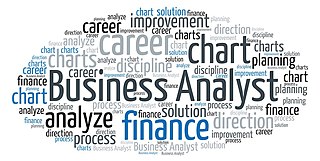Related Research Articles
Business intelligence (BI) comprises the strategies and technologies used by enterprises for the data analysis and management of business information. Common functions of business intelligence technologies include reporting, online analytical processing, analytics, dashboard development, data mining, process mining, complex event processing, business performance management, benchmarking, text mining, predictive analytics, and prescriptive analytics.
A management information system (MIS) is an information system used for decision-making, and for the coordination, control, analysis, and visualization of information in an organization. The study of the management information systems involves people, processes and technology in an organizational context.
In the field of management, strategic management involves the formulation and implementation of the major goals and initiatives taken by an organization's managers on behalf of stakeholders, based on consideration of resources and an assessment of the internal and external environments in which the organization operates. Strategic management provides overall direction to an enterprise and involves specifying the organization's objectives, developing policies and plans to achieve those objectives, and then allocating resources to implement the plans. Academics and practicing managers have developed numerous models and frameworks to assist in strategic decision-making in the context of complex environments and competitive dynamics. Strategic management is not static in nature; the models can include a feedback loop to monitor execution and to inform the next round of planning.
Marketing management is the organizational discipline which focuses on the practical application of marketing orientation, techniques and methods inside enterprises and organizations and on the management of a firm's marketing resources and activities.

SWOT analysis is a strategic planning and strategic management technique used to help a person or organization identify Strengths, Weaknesses, Opportunities, and Threats related to business competition or project planning. It is sometimes called situational assessment or situational analysis. Additional acronyms using the same components include TOWS and WOTS-UP.
Marketing strategy is an organization's promotional efforts to allocate its resources across a wide range of platforms, channels to increase its sales and achieve sustainable competitive advantage within its corresponding market.
In strategic management, situation analysis refers to a collection of methods that managers use to analyze an organization's internal and external environment to understand the organization's capabilities, customers, and business environment. The situation analysis can include several methods of analysis such as the 5C analysis, SWOT analysis and Porter's five forces analysis.

A business analyst (BA) is a person who processes, interprets and documents business processes, products, services and software through analysis of data. The role of a business analyst is to ensure business efficiency increases through their knowledge of both IT and business function.
Competitive intelligence (CI) is the process and forward-looking practices used in producing knowledge about the competitive environment to improve organizational performance. It involves the systematic collection and analysis of information from multiple sources, and a coordinated CI program. It is the action of defining, gathering, analyzing, and distributing intelligence about products, customers, competitors, and any aspect of the environment needed to support executives and managers in strategic decision making for an organization.
A technology roadmap is a flexible planning schedule to support strategic and long-range planning, by matching short-term and long-term goals with specific technology solutions. It is a plan that applies to a new product or process and may include using technology forecasting or technology scouting to identify suitable emerging technologies. It is a known technique to help manage the fuzzy front-end of innovation. It is also expected that roadmapping techniques may help companies to survive in turbulent environments and help them to plan in a more holistic way to include non-financial goals and drive towards a more sustainable development. Here roadmaps can be combined with other corporate foresight methods to facilitate systemic change.
Organizational intelligence (OI) is the capability of an organization to comprehend and create knowledge relevant to its purpose; in other words, it is the intellectual capacity of the entire organization. With relevant organizational intelligence comes great potential value for companies and organizations to figure out where their strengths and weaknesses lie in responding to change and complexity.
Technology forecasting attempts to predict the future characteristics of useful technological machines, procedures or techniques. Researchers create technology forecasts based on past experience and current technological developments. Like other forecasts, technology forecasting can be helpful for both public and private organizations to make smart decisions. By analyzing future opportunities and threats, the forecaster can improve decisions in order to achieve maximum benefits. Today, most countries are experiencing huge social and economic changes, which heavily rely on technology development. By analyzing these changes, government and economic institutions could make plans for future developments. However, not all of historical data can be used for technology forecasting, forecasters also need to adopt advanced technology and quantitative modeling from experts’ researches and conclusions.
Real-time business intelligence (RTBI) is a concept describing the process of delivering business intelligence (BI) or information about business operations as they occur. Real time means near to zero latency and access to information whenever it is required.
Technology scouting is an element of technology management in which
Corporate foresight has been conceptualised by strategic foresight practitioners and academics working and/or studying corporations as a set of practices, a set of capabilities and an ability of a firm. It enables firms to detect discontinuous change early, interpret its consequences for the firm, and inform future courses of action to ensure the long-term survival and success of the company.
An enterprise planning system covers the methods of planning for the internal and external factors that affect an enterprise.
Threat Intelligence Platform (TIP) is an emerging technology discipline that helps organizations aggregate, correlate, and analyze threat data from multiple sources in real time to support defensive actions. TIPs have evolved to address the growing amount of data generated by a variety of internal and external resources (such as system logs and threat intelligence feeds) and help security teams identify the threats that are relevant to their organization. By importing threat data from multiple sources and formats, correlating that data, and then exporting it into an organization’s existing security systems or ticketing systems, a TIP automates proactive threat management and mitigation. A true TIP differs from typical enterprise security products in that it is a system that can be programmed by outside developers, in particular, users of the platform. TIPs can also use APIs to gather data to generate configuration analysis, Whois information, reverse IP lookup, website content analysis, name servers, and SSL certificates.
An intelligence engine is a type of enterprise information management that combines business rule management, predictive, and prescriptive analytics to form a unified information access platform that provides real-time intelligence through search technologies, dashboards and/or existing business infrastructure. Intelligence Engines are process and/or business problem specific, resulting in industry and/or function-specific marketing trademarks associated with them. They can be differentiated from enterprise resource planning (ERP) software in that intelligence engines include organization-level business rules and proactive decision management functionality.
Innovation management measurement helps companies in understanding the current status of their innovation capabilities and practices. Throughout this control areas of strength and weakness are identified and the organizations get a clue where they have to concentrate on to maximize the future success of their innovation procedures. Furthermore, the measurement of innovation assists firms in fostering an innovation culture within the organization and in spreading the awareness of the importance of innovation. It also discloses the restrictions for creativity and opportunity for innovation. Because of all these arguments it is very important to measure the degree of innovation in the company, also in comparison with other companies. On the other hand, firms have to be careful not to misapply the wrong metrics, because they could threaten innovation and influence thinking in the wrong way.
Competitive landscape is a business analysis method that identifies direct or indirect competitors to help comprehend their mission, vision, core values, niche market, strengths, and weaknesses. Based on the volatile nature of the business world, where companies represent a competition to others, this analysis helps to establish a new mind-set which facilitates the creation of strategic competitiveness.
References
- ↑ Technology intelligence: Identifying threats and opportunities from new technologies Archived 2008-04-03 at the Wayback Machine Mortara, L. and Kerr, C. and Phaal, R. and Probert, D., University of Cambridge (2007)
- ↑ Smith, Esther (1988-05-05). "DoD Unveils Competitive Tool: Project Socrates Offers Valuable Analysis". Washington Technology.
- 1 2 A conceptual model for technology intelligence. International Journal of Technology Intelligence and Planning Volume 2, Number 1, pp. 73-93. ISSN 1740-2832, Kerr, C. I. V.; Mortara, L.; Phaal, R. & Probert, D. R. (2006)
- 1 2 3 4 Veugelers, Mark; Bury, Jo; Viaene, Stijn (February 2010). "Linking technology intelligence to open innovation". Technological Forecasting and Social Change. 77 (2): 335–343. doi:10.1016/j.techfore.2009.09.003.
- 1 2 Chaudhuri, Surajit; Dayal, Umeshwar; Narasayya, Vivek (1 August 2011). "An overview of business intelligence technology". Communications of the ACM. 54 (8): 88. doi: 10.1145/1978542.1978562 .
- 1 2 3 4 5 Bergeron, Pierrette; Hiller, Christine A. (2005-02-01). "Competitive intelligence". Annual Review of Information Science and Technology. 36 (1): 353–390. doi:10.1002/aris.1440360109.
- 1 2 3 Norling, Parry M.; Herring, Jan P.; Rosenkrans, Wayne A.; Stellpflug, Marcia; Kaufman, Stephen B. (September 2000). "Putting Competitive Technology Intelligence To Work". Research-Technology Management. 43 (5): 23–28. doi:10.1080/08956308.2000.11671377. ISSN 0895-6308. S2CID 150567921.
- 1 2 3 Savioz, Pascal; Tschirky, Hugo (2004), "Technology Intelligence System: Benefits and Roles of Top Management", Bringing Technology and Innovation into the Boardroom, Palgrave Macmillan UK, pp. 220–236, doi:10.1057/9780230512771_10, ISBN 978-1-349-43246-2
- 1 2 3 4 5 6 7 Lichtenthaler, Eckhard (September 2003). "Third generation management of technology intelligence processes". R and D Management. 33 (4): 361–375. doi:10.1111/1467-9310.00304. ISSN 0033-6807.
- 1 2 3 4 5 Yoon, B (July 2008). "On the development of a technology intelligence tool for identifying technology opportunity". Expert Systems with Applications. 35 (1–2): 124–135. doi:10.1016/j.eswa.2007.06.022.
- 1 2 Mietzner, Dana; Reger, Guido (2005). "Advantages and disadvantages of scenario approaches for strategic foresight". International Journal of Technology Intelligence and Planning. 1 (2): 220. doi:10.1504/ijtip.2005.006516. ISSN 1740-2832. S2CID 16613397.
- ↑ Brenner, Merrill S. (1996). "Technology intelligence and technology scouting". Competitive Intelligence Review. 7 (3): 20–27. doi:10.1002/cir.3880070306.
- Technology Intelligence systems: how companies keep track of the latest technological developments, ifM Briefing, University of Cambridge, 2007
- Technological change and the technology intelligence process: A case study. Journal of Engineering and Technology Management,Vol. 21, No. 4, pp. 331–348, Lichtenthaler, E. (2004)
- Putting competitive technology intelligence to work. Research-Technology Management Vol. 43, No. 5, pp. 23–28, Norling, P. M.; Herring, J. P.; Rosenkrans, W. A.; Stellpflug, M. & Kaufmann, S. B. (2000)